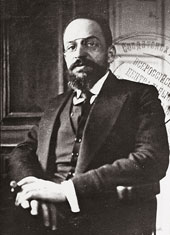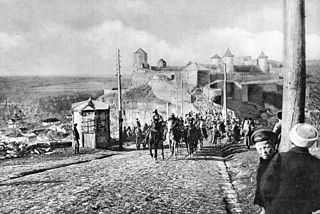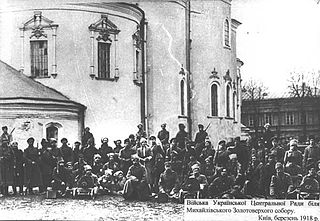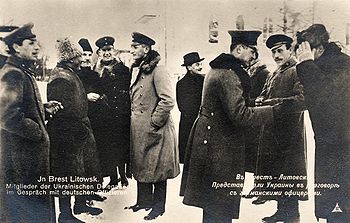
The Treaty of Brest-Litovsk was a separate peace treaty signed on 3 March 1918 between Soviet Russia and the Central Powers, by which Russia withdrew from World War I. The treaty, which followed months of negotiations after the armistice on the Eastern Front in December 1917, was signed at Brest-Litovsk.

Adolph Abramovich Joffe was a Russian revolutionary, a Bolshevik politician and a Soviet diplomat of Karaite descent.

The Soviet westward offensive of 1918–1919 was part of the campaign by Soviet Russia into areas abandoned by the Ober Ost garrisons that were being withdrawn to Germany following that country's defeat in World War I. The initially successful offensive against the Republic of Estonia ignited the Estonian War of Independence which ended with the Soviet recognition of Estonia. Similarly, the campaigns against the Republic of Latvia and Republic of Lithuania ultimately failed, resulting in the Latvian–Soviet Peace Treaty and Soviet–Lithuanian Peace Treaty respectively. In Belarus, the Belarusian People's Republic was conquered and the Socialist Soviet Republic of Byelorussia proclaimed.

The Central Rada of Ukraine, also called the Central Council, was the All-Ukrainian council that united deputies of soldiers, workers, and peasants deputies as well as few members of political, public, cultural and professional organizations of the Ukrainian People's Republic. After the All-Ukrainian National Congress, the Council became the revolutionary parliament in the interbellum lasting until the Ukrainian-Soviet War. Unlike many other councils in the Russian Republic, bolshevization of this council failed completely, prompting the Bolsheviks in Ukraine to relocate to Kharkov.

During the Polish–Soviet War of 1919–1921, Soviet Russia and its client state, Soviet Ukraine, were in combat with the re-established Second Polish Republic and the newly established Ukrainian People's Republic. Both sides aimed to secure territory in the often disputed areas of the Kresy, in the context of the fluidity of borders in Central and Eastern Europe in the aftermath of World War I and the breakdown of the Austrian, German, and Russian Empires. The first clashes between the two sides occurred in February 1919, but full-scale war did not break out until the following year. Especially at first, neither Soviet Russia, embroiled in the Russian Civil War, nor Poland, still in the early stages of state re-building, were in a position to formulate and pursue clear and consistent war aims.

Stepan Porfyrovych Vytvytskyi, also known as Dr. Stepan Wytwycky, was a Ukrainian politician, diplomat, and journalist. He was the President of the Ukrainian People's Republic in exile (1954–1965).

Various factions fought over Ukrainian territory after the collapse of the Russian Empire following the Russian Revolution of 1917 and after the First World War ended in 1918, resulting in the collapse of Austria-Hungary, which had ruled Ukrainian Galicia. The crumbling of the empires had a great effect on the Ukrainian nationalist movement, and in a short period of four years a number of Ukrainian governments sprang up. This period was characterized by optimism and by nation-building, as well as by chaos and civil war. Matters stabilized somewhat in 1921 with the territory of modern-day Ukraine divided between Soviet Ukraine and Poland, and with small ethnic-Ukrainian regions belonging to Czechoslovakia and to Romania.

The Odessa Soviet Republic was a short-lived Soviet republic formed on 30 January [O.S. 17 January] 1918 from parts of the Kherson and Bessarabia Governorates of the former Russian Empire.

The history of Ukrainian nationality can be traced back to the kingdom of Kievan Rus' of the 9th to 12th centuries. It was the predecessor state to what would eventually become the Eastern Slavic nations of Belarus, Russia, and Ukraine. During this time, Eastern Orthodoxy, a defining feature of Ukrainian nationalism, was incorporated into everyday life.

The Ukrainian War of Independence, also referred to as the Ukrainian–Soviet War in Ukraine, lasted from March 1917 to November 1921. It saw the establishment and development of an independent Ukrainian republic, most of which was absorbed into the Soviet Union as the Ukrainian Soviet Socialist Republic of 1922–1991.

The Ukrainian People's Army, also known as the Ukrainian National Army (UNA) or by the derogatory term Petliurivtsi, was the army of the Ukrainian People's Republic (1917–1921). They were often quickly reorganized units of the former Imperial Russian Army or newly formed volunteer detachments that later joined the national armed forces. The army lacked a certain degree of uniformity, adequate leadership to keep discipline and morale. Unlike the Ukrainian Galician Army, the Ukrainian People's Army did not manage to evolve a solid organizational structure, and consisted mostly of volunteer units, not regulars.
The People's Secretariat of Ukraine was the executive body of the Provisional Central Executive Committee of Soviets in Ukraine. It was formed in Kharkiv on December 30, 1917, as a form of the Soviet concept of dual power by the Russian and other local Bolsheviks thus forming the Ukrainian Soviet government and the opposition to the Central Rada and the General Secretariat of Ukraine. The government claimed the same jurisdiction over Ukraine as the General Secretariat. The Central Executive Committee of Ukraine that was elected by the First All-Ukrainian Congress of Soviets canceled the declaration of independence, declared that Ukraine is in a federal subordination to the Russian SFSR, and called on to fight against the separatists, the Ukrainian Central Rada and the General Secretariat of Ukraine.
The Council of People's Ministers of Ukraine was the main executive institution of the Ukrainian People's Republic. Its duties and functions were outlined in the Chapter V of the Constitution of the Ukrainian People's Republic.

The Battle of Kiev of January 1918 was a Bolshevik military operation of Petrograd and Moscow Red Guard formations directed to capture the capital of Ukraine. The operation was led by Red Guards commander Mikhail Artemyevich Muravyov as part of the Soviet expeditionary force against Kaledin and the Central Council of Ukraine. The storming of Kiev (Kyiv) took place during the ongoing peace negotiations at Brest-Litovsk on 5–8 February 1918. The operation resulted in the occupation of the city by Bolshevik troops on 9 February and the evacuation of the Ukrainian government to Zhytomyr.

The Operation Faustschlag, also known as the Eleven Days' War, was a Central Powers offensive in World War I. It was the last major action on the Eastern Front.

The Ukrainian People's Republic (UPR) was a short-lived state in Eastern Europe. Prior to its proclamation, the Central Council of Ukraine was elected in March 1917 as a result of the February Revolution, and in June, it declared Ukrainian autonomy within Russia. Its autonomy was later recognized by the Russian Provisional Government. Following the October Revolution, the Central Council of Ukraine denounced the Bolshevik seizure of power and proclaimed the Ukrainian People's Republic with a territory including the area of approximately eight Russian imperial governorates. It formally declared its independence from Russia on 22 January 1918.

The Ukrainian–Soviet War is the term commonly used in post-Soviet Ukraine for the events taking place between 1917–21, nowadays regarded essentially as a war between the Ukrainian People's Republic and the Bolsheviks. The war ensued soon after the October Revolution when Lenin dispatched Antonov's expeditionary group to Ukraine and Southern Russia.

On 15 December [O.S. 2 December] 1917, an armistice was signed between the Russian Soviet Federative Socialist Republic on the one side and the Austro-Hungarian Empire, the Kingdom of Bulgaria, the German Empire and the Ottoman Empire—the Central Powers—on the other. The armistice took effect two days later, on 17 December [O.S. 4 December]. By this agreement Russia de facto exited World War I, although fighting would briefly resume before the Treaty of Brest-Litovsk was signed on 3 March 1918, and Russia made peace.
Central Powers intervention in the Russian Civil War consisted of a series of multi-national military expeditions starting in 1918. This intervention was picking up from the Eastern Front against the newly set up Russian Republic. The main goals of the intervention were to maintain the territories received in the Treaty of Brest-Litovsk, prevent a re-establishment of the Eastern Front, and administer new conquered territories. After the defeat of the Central Powers, many armies that stayed mostly helped the Russian White Guard eradicate communists in the Baltics until their eventual withdrawal and defeat. In addition, pro-German factions fought against the newly independent Baltic states until their defeat by the Baltic States, backed by the victorious Allies.
The Establishment of Soviet power in Russia was the process of establishing Soviet power throughout the territory of the former Russian Empire, with the exception of areas occupied by the troops of the Central Powers, following the seizure of power in Petrograd on October 25, 1917, and in mostly completed by the beginning of the German offensive along the entire front on February 18, 1918.




















